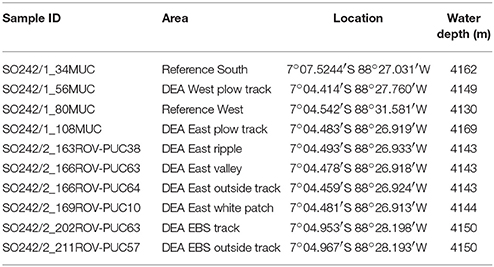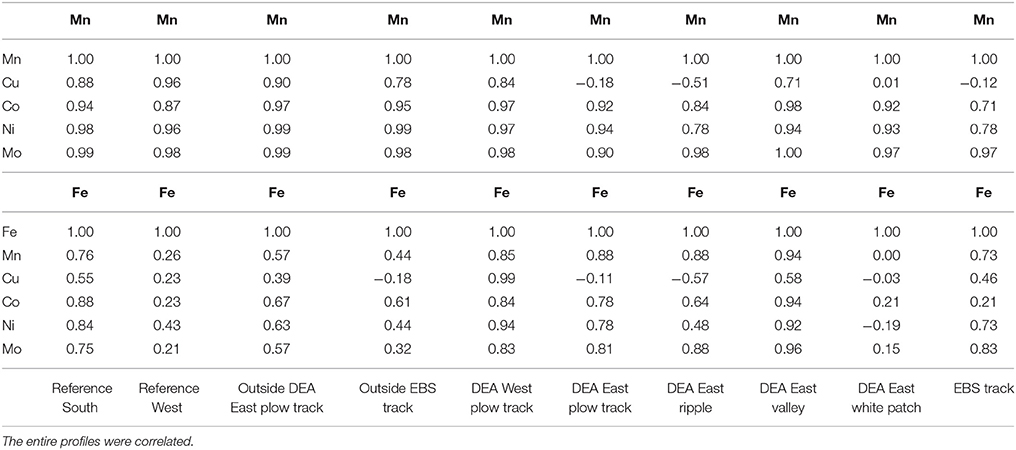Biogeochemical Regeneration of a Nodule Mining Disturbance Site: Trace Metals, DOC and Amino Acids in Deep-Sea Sediments and Pore Waters
- 1Department of Physics and Earth Sciences, Jacobs University Bremen, Bremen, Germany
- 2Institute of Geology, University of Hamburg, Hamburg, Germany
- 3GEOMAR Helmholtz Centre for Ocean Research Kiel, Kiel, Germany
- 4Alfred Wegener Institute, Helmholtz Centre for Polar and Marine Research, Bremerhaven, Germany
- 5Faculty of Geosciences, University of Bremen, Bremen, Germany
Increasing interest in deep-sea mineral resources, such as polymetallic nodules, calls for environmental research about possible impacts of mineral exploitation on the deep-sea ecosystem. So far, little geochemical comparisons of deep-sea sediments before and after mining induced disturbances have been made, and thus long-term environmental effects of deep-sea mining are unknown. Here we present geochemical data from sediment cores from an experimental disturbance area at 4,100 m water depth in the Peru Basin. The site was revisited in 2015, 26 years after a disturbance experiment mimicking nodule mining was carried out and compared to sites outside the experimental zone which served as a pre-disturbance reference. We investigated if signs of the disturbance are still visible in the solid phase and the pore water after 26 years or if pre-disturbance conditions have been re-established. Additionally, a new disturbance was created during the cruise and sampled 5 weeks later to compare short- and longer-term impacts. The particulate fraction and pore water were analyzed for major and trace elements to study element distribution and processes in the surface sediment. Pore water and bottom water samples were also analyzed for oxygen, nitrate, dissolved organic carbon, and dissolved amino acids, to examine organic matter degradation processes. The study area of about 11 km2 was found to be naturally more heterogeneous than expected, requiring an analysis of spatial variability before the disturbed and undisturbed sites can be compared. The disturbed sites exhibit various disturbance features: some surface sediments were mixed through, others had the top layer removed and some had additional material deposited on top. Pore water constituents have largely regained pre-disturbance gradients after 26 years. The solid phase, however, shows clear differences between disturbed and undisturbed sites in the top 20 cm so that the impact is still visible in the plowed tracks after 26 years. Especially the upper layer, usually rich in manganese-oxide and associated metals, such as Mo, Ni, Co, and Cu, shows substantial differences in metal distribution. Hence, it can be expected that disturbances from polymetallic nodule mining will have manifold and long-lasting impacts on the geochemistry of the underlying sediment.
Introduction
Deep-sea mining has been featured prominently on the political and scientific agenda for the past years and experiences a new phase of interest after first major exploration activities in the 1970s and 1980s. Recent advances in deep-sea mining technology, such as the building of collector prototypes, (Gollner et al., 2017) and an increasing number of exploration contracts issued by the International Seabed Authority (ISA): seven of 16 in the last 5 years (International Seabed Authority, 2014) show the need for environmental baseline data and knowledge about the response of deep-sea sediments to impacts by polymetallic nodule mining. The number of articles discussing the need for mining regulation to protect the deep-sea ecosystem and its fauna has skyrocketed in recent years (Glover and Smith, 2003; Davies et al., 2007; Ramirez-Llodra et al., 2011; van Dover, 2011; Barbier et al., 2014; Mengerink et al., 2014; van Dover et al., 2014). Yet, most research on trace metals in deep-sea sediments is approximately 30 years old (Klinkhammer, 1980; Klinkhammer et al., 1982; Sawlan and Murray, 1983; Heggie and Lewis, 1984; Heggie et al., 1986; Müller et al., 1988; Shaw et al., 1990) and recent trace metal research mostly does not focus on the deep-sea (Morford and Emerson, 1999; Morford et al., 2005; Beck et al., 2008; Kowalski et al., 2009). Therefore, more state-of-the-art deep-sea sediment studies focusing on the current issue of mining impacts are needed.
Exploration for polymetallic nodules has been carried out in many different areas of the oceans, with a focus on the Clarion-Clipperton Fractures Zone (CCZ) in the central Pacific (Hein et al., 2013). There, nodules have a high percentage of economically interesting metals—Ni, Cu, and Co (Hein et al., 2013). All ISA exploration contract areas except one are located in the CCZ (International Seabed Authority, 2014); however, some long-term research projects on the impacts of nodule mining on the deep-sea ecosystem have also been carried out in the Peru Basin. Polymetallic nodules in the Peru Basin are characterized by higher growth rates and larger size in comparison to the CCZ nodules (Marchig et al., 2001). Cu contents are generally lower than in CCZ nodules (Wegorzewski and Kuhn, 2014). The overlying waters are more productive than in the CCZ and hence, sediments are characterized by higher organic carbon concentrations of around 0.5 wt% up to rarely 1 wt%, low sedimentation rates (0.4–2.0 cm/ka) and an oxygen penetration depth around 10–15 cm (Haeckel et al., 2001).
In 1989, a DISturbance and reCOLonization (DISCOL) experiment mimicking polymetallic nodule mining was carried out in the Peru Basin. The deep-sea floor was plowed in an area of approximately 11 km2 (Thiel, 2001). Environmental assessments were carried out 0.5, 3, and 7 years after the disturbance (Thiel, 2001). The assessments, however, mainly focused on fauna (Thiel and Schriever, 1990) and the first geochemical studies in the wider DISCOL area were conducted in 1996 (cruise SO106, ATESEPP project), unfortunately only after the disturbance so that no baseline data from prior to the experiment exists. The six sampling sites of SO106 were spread out across the Peru Basin and only one site was located in the DISCOL experimental area (DEA) (Schriever et al., 1996). It is not known, however, if the 1996 DISCOL sample is from within or outside a plow track because the multi-corer (MUC) sampling then was not TV-guided and the geochemical data (Koschinsky, 2001) does not give a clear picture to draw conclusions about a disturbance.
Mining operations to recover nodules will likely remove or disturb the upper 10–50 cm of sediment and create a sediment plume (Thiel and Schriever, 1990; Oebius et al., 2001; Cronan et al., 2010; Gollner et al., 2017). Ex-situ experiments with sediment cores from the Peru Basin showed that pore water metals, dissolved organic carbon (DOC) and nutrients are released when the sediment is stirred up (Koschinsky et al., 2001b). It has been assumed that such a disturbance would also be caused by polymetallic nodule mining (Thiel and Forschungsverbund Tiefsee-Umweltschutz, 2001). Depending on the redox zonation of the area and depth of sediment removal, a change in redox zonation can occur. The redox zonation develops as a result of organic matter degradation, following a roughly set sequence in which oxidants are used according to their potential to produce energy: oxygen, nitrate, Mn-oxide, Fe-oxide, and sulfate (Froelich et al., 1979). The redox zonation in marine sediments determines how metals are distributed between the solid phase and pore water: metals are either bound in the solid phase or dissolved in the pore water (König et al., 2001; Koschinsky, 2001). Elements soluble in oxic water (Mo, U, possibly V, As) are released from oxic pore water, but they have similar concentrations in the oxic bottom water (Koschinsky, 2001). Mn, Fe, Co, Ni, Cu, Zn, Cd, and Pb have higher concentrations in the sediment pore water than in the bottom water, especially in suboxic pore water, which are up to two orders of magnitude higher than in the bottom water at the sediment-water interface (Koschinsky, 2001). If the oxic layer is thick enough (few cm), most pore water metals diffusing upwards from the suboxic layer will be scavenged and bound to e.g. Mn-oxides because Mn-oxides are effective scavengers and positively charged metal species such as Co, Ni, Cu, Zn, Pb, and Cd are associated with Mn (Koschinsky, 2001). Similarly, if the disturbance is limited to the oxic layer, Mn-oxides would bind most of the released heavy metals in a relatively short period of time (Koschinsky et al., 2001b) which makes them immobile and they do not diffuse into the bottom water (Koschinsky, 2001; Morford et al., 2005). The depth of the oxic layer hence is a decisive factor for the heavy metal budget (Koschinsky, 2001). Besides the Mn-oxide rich surface layer, polymetallic nodules also act as metal scavengers (Koschinsky et al., 2003). If these nodules are mined, this option of metal scavenging is removed. If, however, the oxic layer is removed or contracted, metals dissolved in the pore water from the suboxic layer can discharge into the oxygenated bottom water, causing the release of dissolved heavy metals and an increase of seawater heavy metal concentrations (König et al., 2001; Koschinsky et al., 2003). Since some heavy metals could potentially reach toxic concentrations with detrimental effects for the fauna, sediment disturbance and potential metal release is a serious issue to be considered with respect to deep-sea nodule mining. Ecotoxicological experiments showed that LC50 values for animals subjected to colder temperatures and higher pressures, to simulate deep-sea environmental conditions, for dissolved Cu ranged between 8.85 and 29.4 μmol/L for nematodes (Mevenkamp et al., 2017) and 380–420 μmol/L for shrimp (Brown et al., 2017a). LC50 values for Cd ranged between 521 and 548 μmol/L for shrimp (Brown et al., 2017a). Experiments are usually carried out with spiked Cu and Cd concentrations in the μmol/L range (Auguste et al., 2016; Martins et al., 2017; Mevenkamp et al., 2017). Trace metals are an important part of the biogeochemical cycle of the surface sediment and should be well understood before mining commences.
These preliminary experiments from the past thus have shed some light on the geochemical behavior of heavy metals in deep-sea sediments. Yet, no detailed in-situ studies or long-term monitoring of the mining impacts have been carried out in the DISCOL area (as mentioned above, only one station was sampled there in 1996) to determine: (1) degrees of disturbance at different sites to obtain a comprehensive picture of the geographic extent and degree of the disturbance and (2) the processes in the sediment and new equilibrium establishment after a disturbance. This is essential as most geochemical processes in the deep-sea are slow and therefore environmental recovery rates can also be expected to be slow.
As part of the European JPI Oceans MiningImpact project (“Ecological Aspects of Deep-Sea Mining”) (GEOMAR, 2017), we revisited the DISCOL area in 2015 during the SO242 cruise with RV SONNE, to study the geochemical long-term development of the site. We aim to answer the following research questions: (1) Are there differences between the reference sites demonstrating natural variability in the particulate fraction and pore water? After 5 weeks and 26 years, (2) are signs of the disturbance still visible in the solid phase and pore water or has a new equilibrium been reached? (3) Are there differences between the disturbed sites across the DEA and between the microhabitats within a disturbed track? Answering these questions will help to understand natural variability and how deep-sea mining could affect the deep-sea floor geochemistry. Since little is still known about sediment recovery after a disturbance, these background studies are extremely valuable—especially if carried out on relatively long time-scales. Decision-makers can also draw from our results as a basis for defining baseline data and threshold values because if the disturbance sites vary considerably, this needs to be taken into account for monitoring in future mining scenarios.
From a research perspective, the DISCOL area provides a good comparison to the well-researched and industrially more pertinent CCZ, where similar studies have been and are being carried out, but the geochemistry is quite different. The DISCOL area has an oxic layer of approximately 10–15 cm (Haeckel et al., 2001), whereas the CCZ sediment is oxic down to ca. 200 cm and deeper (Mewes et al., 2014, 2016; Kuhn et al., 2017). A comparison of these sites will help to assess the possible range of changes in the trace metal cycle during deep-sea mining in relation to the different environmental conditions.
Materials and Methods
Site Description
The Peru Basin is located in the south eastern tropical Pacific (Marchig et al., 2001). Predominantly, siliceous and calcareous muds and oozes make up the sediments in this region (Weber et al., 1995). For detailed site description of the DISCOL area and the disturbance experiment carried out in 1989 please refer to Thiel and Schriever (1990); Boetius (2015); Greinert (2015).
During RV SONNE cruise legs SO242/1 and 2 in 2015, the reference sites outside the DEA (Figure 2A), as well as undisturbed and disturbed sites inside the DEA were sampled (Figure 1). The 26-year old plowed tracks exhibit various disturbance features. Due to the plow harrow, grooves traverse the sediment and form ripples and valleys. Throughout the DEA “white patches” of lighter sediment occur in the disturbed sites. These three features are microhabitats of the disturbed sites, which were sampled to study the disturbance variety (Figure 2C).
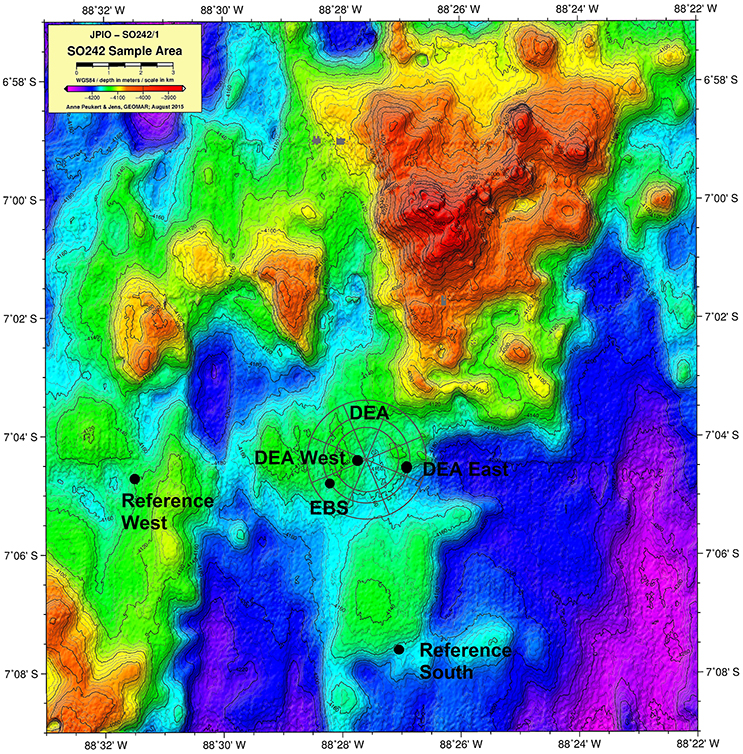
Figure 1. Sampling sites of sediment cores in the DISCOL area (adapted from a map by Anne Peukert, GEOMAR, working group of Jens Greinert). The circle indicates the DISCOL experimental area (DEA) in which the disturbance experiment had been carried out in 1989.
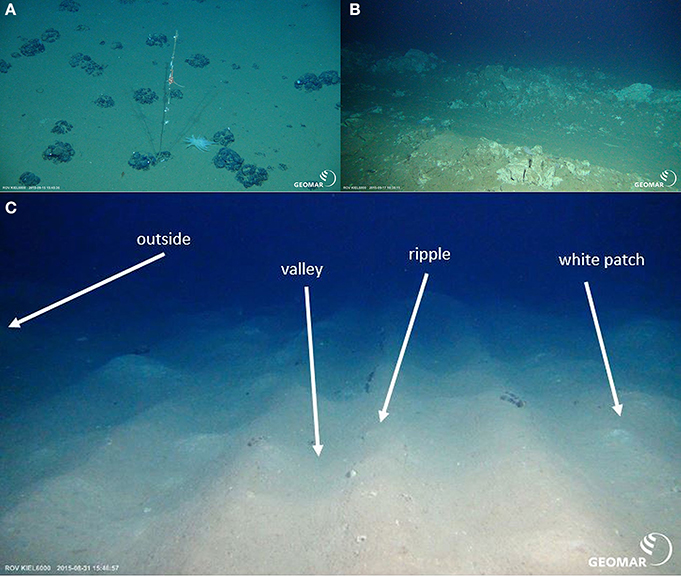
Figure 2. (A) Example of seafloor at a reference site, (B) example of an EBS track, (C) example of a 26-year old plow track, indicating the four microhabitats outside track, track valley, ripple, and white patch. Pictures copyright ROV KIEL 6000 Team, GEOMAR Helmholtz Centre for Ocean Research Kiel, Germany.
During leg SO242/1 (Greinert, 2015), a new disturbance in addition to the plow tracks from 1989 was created using an epibenthic sled (EBS), and the affected sites were sampled approximately 5 weeks later during leg SO242/2. The sediment surface layer was visibly removed so that the lighter sediment below the Mn-oxide rich layer became exposed (Figure 2B). The EBS track sediment disturbance was created to simulate nodule mining and to be able to take samples for geochemical analyses shortly after the disturbance. This had not been done in the frame of the original DISCOL project and geochemical data from shortly after the impact is missing. Therefore, the EBS track samples add a point in time between undisturbed samples and samples from the 26-year old disturbance. It is important to note, however, that the tracks created 26 years ago were created using a plow harrow, which affects the sediment in a different way than the EBS. The general disturbance impact is comparable, but variations due to the gear used are probable.
Sediment and Pore Water Sampling
Sediment was collected using MUC and ROV push cores (ROV-PUC). TV-guided MUCs allowed for exact sampling of the tracks, while the precision with the ROV was even higher and microhabitats within the plow tracks could be sampled. The cores were immediately brought into the 4°C cold room of RV SONNE and for trace element and DOC analyses, sliced into 2 cm layers in a glove bag filled with argon. The sediment slices were transferred into 50 mL acid-cleaned centrifuge tubes in the glove bag and centrifuged at 3,200 rpm for 40 min. The supernatant was filtered through 0.2 μm cellulose acetate syringe filters, pre-cleaned with 0.1 M hydrochloric (HCl) acid and deionized water, again using a glove box. The water overlying the particulate fraction within the MUC liner was sampled as well to get bottom water values for each core. The pore water samples were acidified to pH 2 with concentrated, suprapure HCl and stored at 4°C. Pore water samples for amino acid analyses were taken with rhizons according to the procedure described by Seeberg-Elverfeldt et al. (2005) and frozen. Pore water samples for nitrate analyses were extracted with a low pressure (argon at 3–5 bar) squeezer using 0.2 μm cellulose acetate filters. An overview of the cores taken at different locations in the working area is given in Table 1.
Chemical Analyses
All acids used were of suprapure quality (HCl and HF by Merck, HClO4 and HNO3 by Roth). All PE containers were acid cleaned prior to use to avoid any trace element contamination.
Solid Phase
Major and trace elements
For bulk chemical analyses, centrifuged sediment samples were crushed and dried at 105°C to remove moisture. 100 mg of sediment were then digested with a PicoTrace DAS acid digestion system using 3 mL perchloric acid (HClO4 70%) and 3 mL hydrofluoric acid (HF 38–40%) at 220°C for 12 h. Samples were evaporated, taken up in 5 mL HCl and evaporated again. This step was repeated before the samples were taken up in a mix of 0.5 M nitric (HNO3) acid and 0.5% HCl (v/v). Samples were analyzed with ICP-OES (SpectroCiros SOP instrument) for major elements and ICP-MS (Perkin Elmer Nexion 350x) for trace elements. For ICP-OES measurements, the certified reference material (CRM) MESS-3 was within 5% accuracy of certified values for Cu, K, Mg, and Mn, and within 10% for Ca, Fe, P, and Zn. Accuracy for Al was −13% but too low values for Al in MESS-3 have been reported before (Roje, 2010). Method precision was within 8% for all elements except P (10%), Mg (13%), and Al (21%). Accuracy of BHVO-2 reference material was within 5% for all elements except P and Zn (12%) and method precision was within 4% for all elements except P (13%). Accuracy for MESS-3 and BHVO-2 for ICP-MS measurements were within 3% except for Pb (−8% MESS-3) and Ni (6% BHVO-2). Method precision was within 3% except for Pb (26%). Cd could not be measured reliably in the reference material due to high discrepancies of the two measured isotopes. For detailed information on limit of quantification1 (LOQ), accuracy, and method precision refer to Supplementary Material 1.
POC and PON
Particulate organic carbon (POC) and particulate organic nitrogen (PON) of the sediment were determined through gas-chromatography of CO2 and N2, produced by flash combustion using a Carlo Erba Element Analyzer (NA 1500). Samples were treated with HCl to release carbon bound to carbonates prior to analysis.
Porosity
Porosity was calculated from the weight difference of wet and freeze-dried sediment. For further details see Haeckel et al. (2001).
Pore Water
Major and trace elements
Pore water major elements were measured with ICP-OES (SpectroCiros SOP instrument). Overall accuracy for IAPSO seawater reference material was within 5% for all measured elements except Mg (+11%). Method precision was 2–3% except for Si (17%). For trace elements (As, Cd, Co, Cu, Mn, Mo, U, V), a ICP-MS (Perkin Elmer Nexion 350x) coupled with an apex Q (ESI) introduction system to increase sensitivity and decrease background was used. As, Co, Cu, Mn, and V were measured in a reaction cell in collision cell mode (KED mode) with helium gas, to eliminate interferences. Cd and Co values of all CRMs are below the LOQ and could not be verified. Mo and U were verified with IAPSO and NASS-6 seawater reference material, V, Mn, Cu, and As were checked in NASS-6, SLEW-3, and SLRS-6. Accuracy and method precision vary for each CRM, possibly due to varying salt contents but generally agree with the reference materials. Only Mo values are slightly too high. For detailed information on LOQ, accuracy, and method precision refer to Supplementary Material 1. Ni, Zn, Cr, and Pb concentrations in the pore water could not be reliably quantified because of poor accuracy (Ni and Zn) or too low concentrations (Pb LOQ = 0.01–2.29 μg/kg; Cr LOQ = 0.32–1.42 μg/kg).
For ICP-OES measurements, 10 ppm Y were used as internal standard and for ICP-MS, a mixed internal standard containing Ru, Re, and Bi was used: 2 ppb without APEX and in KED mode and 1 ppb with APEX.
DOC
DOC concentrations [mg/L] were determined via a high temperature combustion method (TOC-VCSH Analyzer, Shimadzu). Inorganic carbon was removed by 2 M HCl prior to injection into the combustion tube where organic carbon is oxidized to CO2 at 680°C with a platinum catalyst. A 5-point calibration from 0.5 to 5 mg DOC/L was used. The error of measurement is less than 2% (for further analytical details see Brockmeyer and Spitzy, 2013).
Amino acids
Total hydrolysable dissolved amino acids (DAA) and hexosamines (HA) of selected samples were analyzed with a Biochrom 30 Amino Acid Analyzer after hydrolysis of ca. 3 ml of filtrate with 6 N HCl for 22 h at 110°C under a pure argon atmosphere. A particle free aliquot was evaporated three times to dryness in order to remove the unreacted HCl; the residue was taken up in an acidic buffer (pH 2.2). After injection and subsequent separation with a cation exchange resin, the individual AA monomers were post-column derivatized with o-phthaldialdehyde in the presence of 2-mercaptoethanol and detected with a Merck Hitachi L-2480 fluorescence detector. Duplicate analysis of a standard solution according to this method results in a relative error of 0.1 to 1.3% for the concentrations of individual AA monomers and 0.2 to 3.0% for individual AA monomers of water samples. Due to acid hydrolysis, aspartic acid and asparagine are both measured as Asp and glutamic acid and glutamine are both measured as Glu.
Oxygen
Oxygen was measured ex-situ using fiber-optic microsensors (FireStingO2 optodes from Pyroscience GmbH, Aachen, Germany) which were lowered into the MUC sediment with a motorized micromanipulator (MU1, Pyroscience GmbH, Aachen, Germany). Measurements were taken in 500 μm steps, with two optodes at the same time. In total, four to six concentration profiles were completed for each MUC core. Method precision was 1% and the detection limit 1 μmol/L. For further details see Haeckel et al. in Greinert (2015).
Nitrate
Nitrate was analyzed on-board RV SONNE directly after sampling using a Hitachi UV/VIS spectrophotometer. The analysis followed standard analytical procedures, measuring nitrate as sulphanile-naphthylamide after reduction with Cd (Grasshoff et al., 1999). The detection limit was 2 μmol/L and analytical precision was 3%.
Detailed tables with results for trace elements, DOC and DAA can be found online at PANGAEA: https://doi.pangaea.de/10.1594/PANGAEA.880596.
Results
Solid Phase
Two reference sites outside the DEA and two sites inside the DEA—next to an old plow mark (DEA East) and the freshly disturbed EBS track—not directly impacted by plowing, were analyzed for a range of background values and to determine natural spatial variability. Based on the natural background conditions we will compare the 26-year old and 5-week old disturbed sites.
The major elements in the sediments of the undisturbed and disturbed sites are Al, Fe, and Ca (Figures 3–5). The latter increases with depth, usually more strongly below 10 cm or displays pronounced peaks between 15 and 20 cm. The major element concentrations in general, as well as the Ca variability, are comparable in the disturbed sites and do not vary substantially from the undisturbed sites (Figure 3 and Supplementary Material 2). Si could not be measured due to the acid digestion procedure using HF. Porosity decreases with depth from approximately 0.93 at the surface to 0.86 at around 15 cm and is slightly higher in the surface sediments of undisturbed sites compared to disturbed sites. Especially the EBS track has a lower porosity at the surface. The slope of decreasing porosity is steeper in the disturbed sites than in the undisturbed sites (Figure 3).
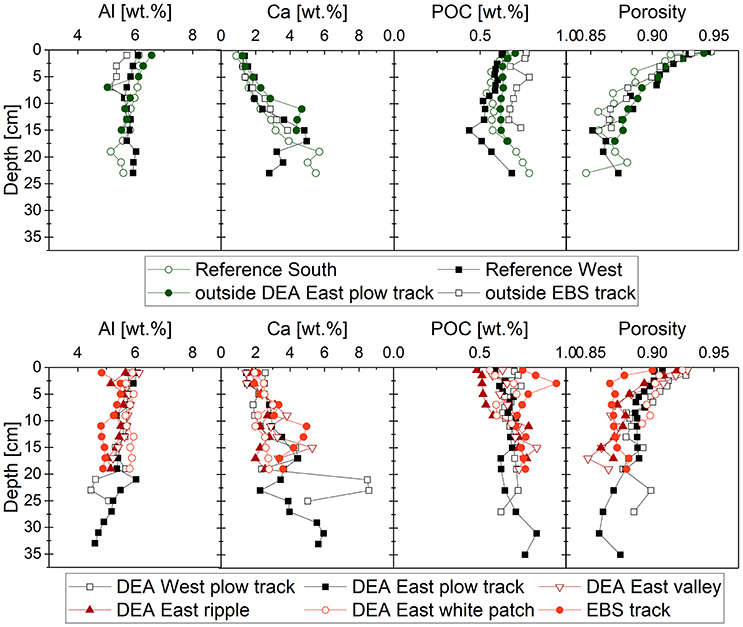
Figure 3. Sediment major element profiles and properties of the four undisturbed and six disturbed sites.
The surface sediments of the undisturbed sites in the DEA have lower Mn concentrations than those of the reference sites but display the same curved profile shape as the reference sites (Figure 4). Additionally, the Mn-oxide rich layer is thicker in the reference sites. POC content is higher within the DEA and lower in Reference South and West. Mo, Ni, Co, Cu, and Cd have similarly curved patterns as Mn. We were only able to get reliable results for Cd in the undisturbed site next to the EBS track. Similar to Mn, the above mentioned Mn-associated metals show slightly higher concentrations at the reference sites compared to the undisturbed sites within the DEA, outside DEA East plow track being the undisturbed site with overall lowest concentrations.
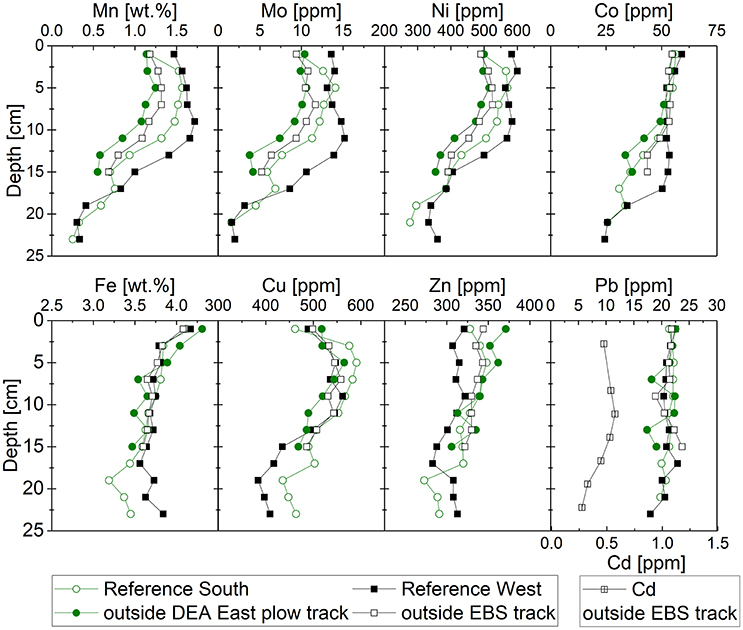
Figure 4. Sediment element profiles of the four undisturbed sites. Reliable Cd results only for outside EBS track.
All disturbed cores have Mn solid phase concentrations below 1.5 wt.%, with DEA West plow track having the highest concentration (up to 1.26 wt%) and the EBS track having by far the lowest concentration (<0.5 wt%) (Figure 5). Mo, Ni, Co, and Cu have similar concentrations at the disturbed sites as at undisturbed sites, only the white patch and the EBS track have considerably lower concentrations of Mo, Ni, and Co. These concentrations are in the same range as the concentrations at depth below the Mn-oxide rich layer in the other cores. The profiles of Mn and associated metals do not show the typical curves as it was the case for the undisturbed sites (Figure 4). They are rather straight (DEA East ripple and valley) or have peaks at depth (DEA East plow track at 23 cm).
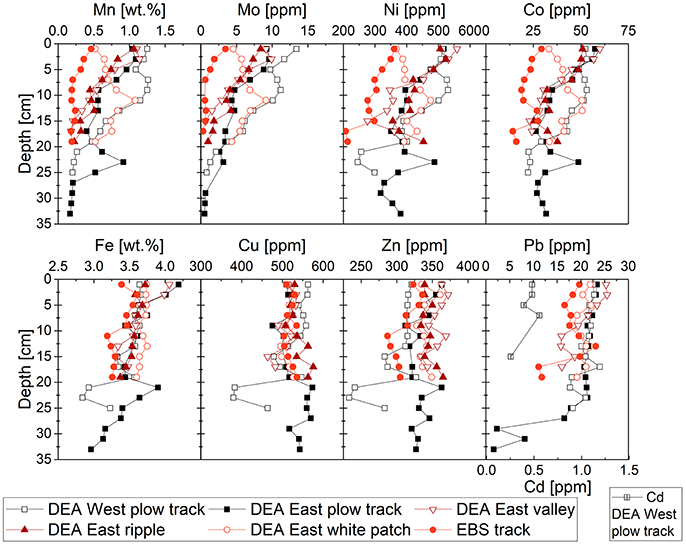
Figure 5. Sediment element profiles of five 26-year old disturbed sites and the 5-week old EBS track. Reliable Cd results only for DEA West plow track.
Pore Water
Pore water ex-situ oxygen profiles (Figure 6) show that the oxygen penetration depth is between 12 and more than 20 cm, decreasing from west to east. It is lower in the DEA plow tracks but this is partly due to the natural gradient. Nevertheless, oxygen profiles from plow track cores are more linear than in undisturbed sites. Oxygen measurements from Vonnahme et al. (in prep.) show that oxygen penetration in the microhabitats is between 11 and 14 cm deep. Nitrate is relatively stable throughout the upper 25 cm of sediment with concentrations between 40 and 60 μmol/L. Below, concentrations slightly decrease as visible in the DEA East plow track profile (Figure 6).
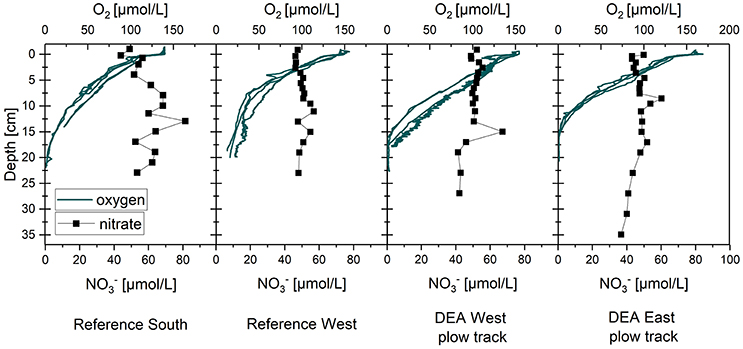
Figure 6. Bottom water and pore water ex-situ oxygen and nitrate profiles of two undisturbed and two disturbed sites (MUCs). In each core, four to six oxygen profiles were measured.
The measured pore water major element concentrations are in the same range for each element across all 10 sites—undisturbed and disturbed—and are mostly in the same range as bottom water concentrations (Supplementary Material 3). Only Si shows the typical increase with depth, which is steepest in the EBS track. Trace element concentrations in the pore waters are in the same range for each element across all undisturbed sites as well (Figure 7). Mn, Mo, U, and As concentrations are generally in the range of bottom water values. Co, Cu, V, Cd, and DOC pore water concentrations are usually twice as high as bottom water concentrations, at least in the upper centimeters. Co is rarely above the LOQ (0.08–0.22 μg/kg) in pore waters of the undisturbed sites. Based on selected best data, we assume the background concentration to be approximately 0.5 nmol/L. Overall, bottom water and pore water trace element concentrations and profiles at the 26-year old plow tracks (Figure 8) are similar to those at undisturbed sites. The surface layer DOC peaks are less pronounced in the disturbed cores but some cores have peaks at greater depths.
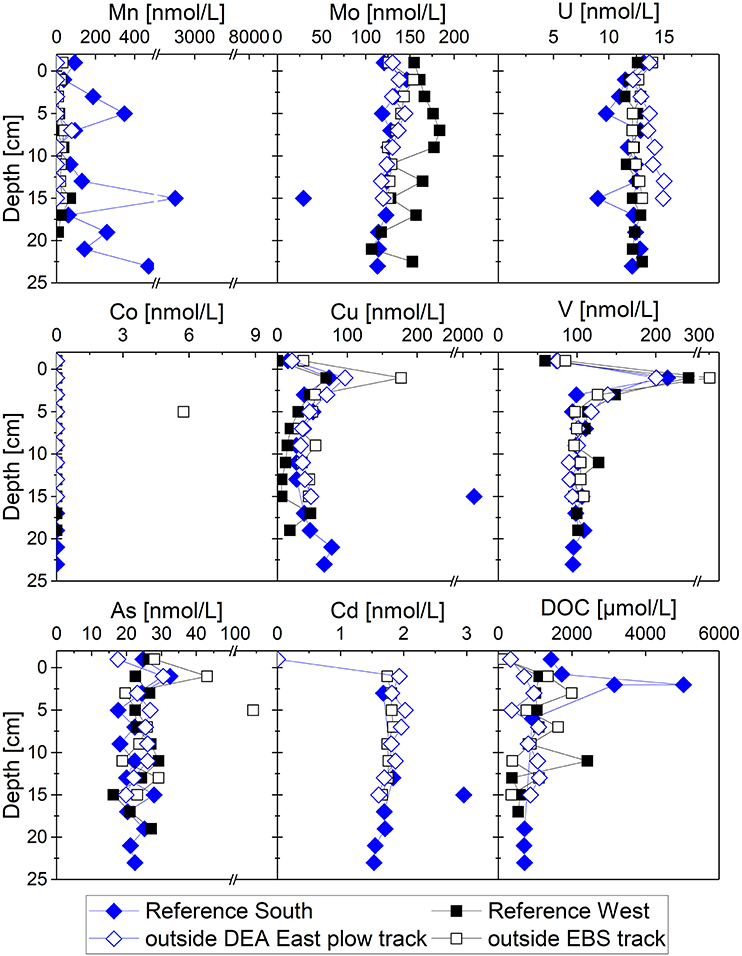
Figure 7. Bottom water and pore water element profiles of the undisturbed sites. The uppermost values refer to bottom water concentrations measured in the supernatant retrieved above the sediment surface in the MUC liner.
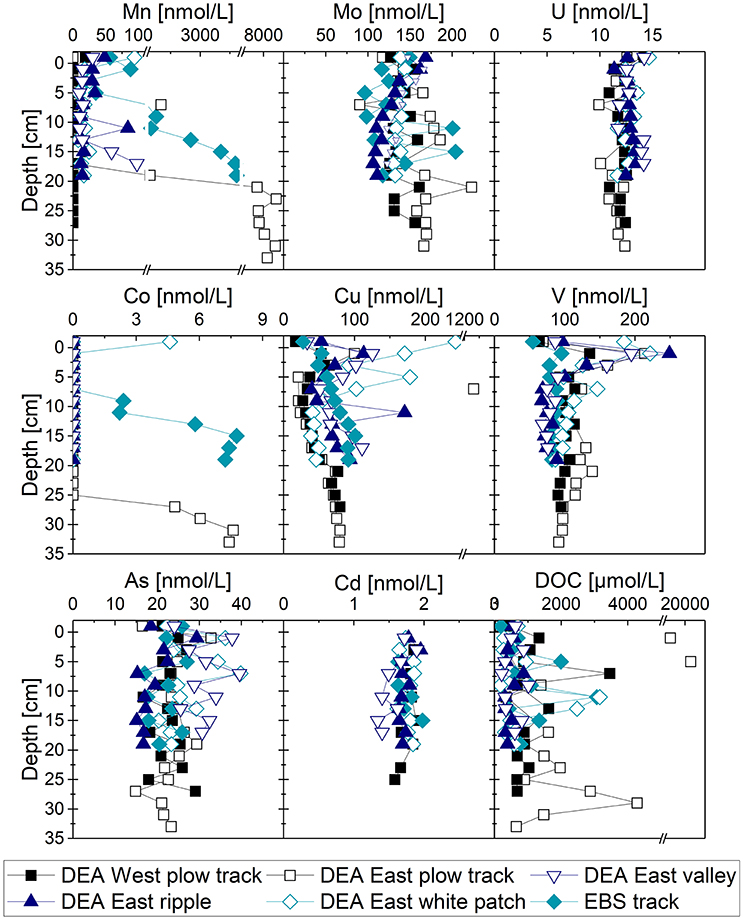
Figure 8. Bottom and pore water element profiles of five 26-year old disturbed sites and the 5-week old EBS track. The uppermost values refer to bottom water concentrations measured in the supernatant retrieved above the sediment surface in the MUC liner. Mn and Co below the LOQ for DEA West plow track.
In some cores—undisturbed and disturbed—local peaks in certain elements occur which could be sampling artifacts from filtration or nanoparticles. Another explanation would be local redox signals, where Mn and associated metals are released into the pore water while Mo and U get removed due to a reducing environment. Diagenetically, however, these peaks cannot be sustained long. These peaks were already found in prior pore water studies in the Peru Basin (see Koschinsky, 2001). Here, they will not be considered further.
Pore water DAA usually have their concentration maxima in the upper 10 cm, best visible for Reference South (Figure 9). At Reference South, the DAA peak roughly coincides with the DOC peak. The pore water DAA concentrations in the 26-year old plow tracks are generally in the same range as in the undisturbed cores with DAA concentrations between 2.2 and 11.1 μmol/L. Peaks in the upper 10 cm are not pronounced (Figure 9). Especially in the DEA East plow track the pore water DAA spectra differ from the undisturbed samples with relatively higher contents of non-protein amino acids β-Ala, γ-Aba as well as Lys, Val, and Met (Supplementary Material 4).
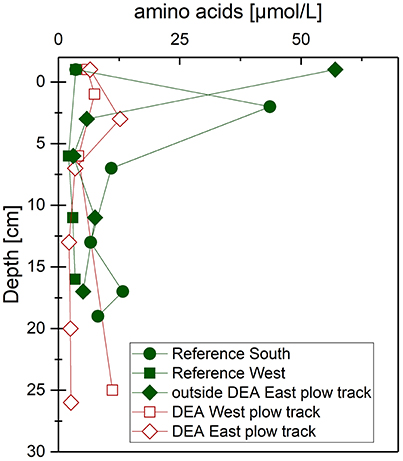
Figure 9. Sum of dissolved amino acid (DAA) concentration profiles of three undisturbed and two disturbed sites. The uppermost values refer to bottom water concentrations measured in the supernatant retrieved above the sediment surface in the MUC liner.
Discussion
Solid Phase: The Mn-Oxide Rich Layer in the Undisturbed Sites
Mn-oxides are the main host phase for heavy metals in the upper 20 cm in the DISCOL area (Koschinsky et al., 2001a; Marchig et al., 2001). The solid phase Mn content decreases steeply around the oxygen penetration depth due to Mn-oxide utilization in organic matter degradation (Figure 4). Oxygen is utilized first because it is energetically the most favorable pathway (Froelich et al., 1979). Once oxygen is consumed, and MnO2 function as electron acceptors. The processes can run in parallel, even though nitrate is the energetically favorable option. Additionally, it has been suggested that the Mn and N cycles are linked and that MnO2 can provide O2 to oxidize N, leading to nitrate formation and Mn-oxide reduction (Mogollón et al., 2016). Since the MnO2 concentration is declining while is still present in the pore water (Figure 6), this might be a relevant process here. The low Mn content (~0.5 wt%) below the Mn reduction zone is likely bound in detrital minerals or Mn-carbonates and represents the constant level of solid phase Mn for sediment below the Mn-oxide rich layer (Gingele and Kasten, 1994; Koschinsky, 2001). The sediments change color from dark brown in the oxic zone to light brown in the suboxic zone, the tan color is due to Fe(III) in the clay minerals (König et al., 1997).
The natural variability of Mn in the oxic layer is 1.1 to 1.7 wt%. There is an increase in Mn content with an increase in oxygen penetration depth, from east to west. Additionally, the reference sites have higher Mn concentrations than the undisturbed sites within the DEA. It remains unclear, if solid phase element concentrations of the undisturbed sites within the DEA are lower solely due to natural variability or because they were impacted by the disturbance as well. Since the undisturbed sites within the DEA are adjacent to plow tracks, they have likely been impacted by resettling suspended sediment from the plowing. Mo, Ni, Co, and Cu are associated with Mn-oxides which is well known from other studies (Klinkhammer et al., 1982; Heggie and Lewis, 1984; Shaw et al., 1990; Koschinsky, 2001; Morford et al., 2005). Mo and Ni show a similar increase from east to west and from the DEA to the reference sites. Co and Cu do not show such variability, though; the concentrations are in the same range for the four undisturbed sites. Correlation coefficients show that of the four metals Cu is least associated with Mn (Table 2). Shaw et al. (1990) only name Mo, Ni, and Co as being associated with Mn-oxides. Cu seems to be neither controlled by the Mn-oxide phase nor by the Fe-oxyhydroxide phase, as indicated by only weak correlation with Mn and Fe (Table 2). Since Cu is generally known to show a high affinity to organic matter, we assume that binding to organic functional groups may play a role in controlling Cu distribution in the surface sediment.
Disturbance Impacts on the Solid Phase: Sediment Removal, Redeposition, and Inversion
Disturbed sediments have lower solid phase Mn concentrations than the undisturbed sediments in the upper 15 cm, suggesting that the top Mn-oxide rich layer has been removed or mixed. This is explicit in the 1 month old disturbance—the EBS track—but also still visible in the profiles of the 26-year old plow tracks (compare Mn in Figures 4, 5). Even though the highest concentrations of the disturbed sites (DEA West plow track) are in the range of the Mn concentrations of the undisturbed sites within the DEA, a comparison of the overall ranges shows that the disturbed sites on average show lower Mn concentrations. Comparing average Mn concentrations of undisturbed and disturbed sites in the individually sampled layers, the 26-year old disturbed sites have 20 to 47% less Mn in the upper 16 cm. Similarly, there is 17 to 48% less Mo in disturbed surface sediments, while Co, Ni and Cu contents are successively less impacted: Co 7 to 25%, Ni 5 to 18% and only Cu −7 to 7%.
The plowing removed most of the Mn-oxide rich layer in the plow tracks and disturbed microhabitats. Only a thin layer is left, the thickness varying between the disturbed sites but being clearly reduced compared to the undisturbed sites. Specifically the white patch does not have a Mn-oxide rich layer left at the sediment surface. The same is true for the EBS track and the tan sediment layer that is usually beneath the dark brown Mn-oxide layer lies at the surface. Since the EBS track sediment is now exposed to the bottom water, trace metals diffuse from the suboxic pore water until a sufficiently thick Mn-oxide layer has formed that scavenges the trace metals. The higher the Mn-oxide content in the surface layer, the lower the diffusive flux of heavy metals into the bottom water and the higher the sorption capacity (Fritsche et al., 2001). Mn-oxides should form with time and the Mn, Mo, Ni, Co, and Cu concentrations in the particulate fraction should slowly increase to establish the typical layering but the time scale of these processes is unknown. The particulate fraction has not yet recovered in these parts but at DEA West and East plow tracks the Mn-oxide rich layer is building up again and it is thicker than in the microhabitats. In conclusion, both, Mn layer thickness and Mn content, are lower in the disturbed sites.
In addition to sediment removal, suspended sediment was deposited on the plow tracks. The sedimentation of suspended sediment was most measurable in the track valley as indicated by increased concentrations of Mn, Mo, Ni, Co, and Fe in the DEA East valley in the upper 2 to 4 cm (Figure 5). The sediment seems to be composed of different material than the sediment further downcore, possibly resettled particles from the Mn-oxide rich layer that were suspended during the plowing. Moreover, the porosity of the valley's surface layer is higher compared to other disturbed sites, proving that loose material was deposited on top. Both impacts have also been found in other biogeochemical investigations (Vonnahme et al., in prep.).
A third impact is sediment inversion, where Mn-oxide rich surface sediment got plowed to greater depth. This is visible in the white patch and the DEA East plow track profiles. At the white patch, the porosity also increases again below this depth, supporting the assumption that surface sediment got turned. At both sites, Mn, Mo, Ni, Co, and Cu show elevated concentrations at 11 and 23 cm, respectively. In other areas of the Peru Basin, a Mn peak at the redox boundary was discovered (Koschinsky, 2001). Internal redox cycling of Mn around the redox boundary can lead to such pronounced solid phase Mn peaks (Burdige, 1993). This is comparable to the marked Mn peak at DEA East plow track (Figure 5) and could be an explanation for the peak because at 25 cm depth the dissolved Mn concentration increases drastically, a clear sign that Mn-oxides are reduced. Since the upper part of the core shows disturbance impacts, we assume that the peak at 23 cm is another sign of the disturbance.
Pore Water Natural State and Impacts Visible 5 Weeks Post-disturbance
The degradation of organic matter during early diagenesis at the sediment-water interface releases various elements to the pore water—e.g., V, Cu, Mo, and DOC (Sawlan and Murray, 1983; Heggie et al., 1986; Shaw et al., 1990; Koschinsky, 2001; Kowalski et al., 2009). In this study, we clearly see this release in form of a marked peak in the top 2 cm of the concentration profiles for V, Cu, and DOC, and to a lesser extent for As (Figures 7, 8). Extensive V peaks at the sediment-water interface can be sustained due to complexation by DOC (Emerson and Huested, 1991; Morford et al., 2005) and because it is not significantly adsorbed to Mn-oxides (Koschinsky, 2001). There are no major differences in the pore water profiles of undisturbed and 26-year post-disturbance sites; the pore water is recovered. Only at DEA West plow track the usual trace metal peak in the top 2 cm is less pronounced, which is interesting considering that DEA West plow track has the least impacted solid phase. The typical peaks of V, Cu, and As in the top 2 cm are not clearly developed yet in the EBS track profile (Figure 8; teal filled diamonds). Even though this feature is already visible in the V profile, the extent of the peak is less than half the concentration of that in the undisturbed and 26-year old disturbed sites from DEA East. This could also be a sign of a lower microbial activity and hence lower rates of organic matter degradation, which usually releases metals to the pore water at the sediment-water interface (Sawlan and Murray, 1983; Heggie et al., 1986; Shaw et al., 1990).
Typically, pore water concentrations of Mn and some associated metals (e.g., Mo, Ni, Co, Cu) increase in the Mn reduction zone as the solid phase concentrations decrease (Froelich et al., 1979; Heggie and Lewis, 1984; Koschinsky, 2001; Morford et al., 2005), approximately below 20 cm in the Peru Basin. This phenomenon is rarely visible in our data except for Cu (Figures 7, 8), as the cores are usually too short to cover the entire Mn reduction zone or the Mn and Co pore water concentrations are below the detection limit when they first increase. The increase is only visible at DEA East plow track (Figure 8) because it is a 35 cm long MUC and we were not able to retrieve those sediment depths with any other core. The Mn and Co concentration increase is natural since it occurs below the redox boundary where such increase is expected, even though the profile is from a disturbed site. Samples taken at the DISCOL area in 1996 also show increasing pore water Mn below 25 cm (Koschinsky, 2001). Correlating with the Mn and Co release, DOC, Mo, and V concentrations increase at the depth of Mn release in the DEA East plow track core. The EBS example indicates, however, that 5 weeks post-disturbance the pore water shows signals of the impact and Mn and Co are already detectable in the pore water at ca. 8 cm depth. This is markedly closer to the sediment-water interface than for the undisturbed and 26-year old disturbed sites. Also, Mo is more variable below 8 cm compared to the largely conservative profiles in the undisturbed sites. Therefore, this difference can be clearly attributed to the disturbance. The sediment profiles show that the entire Mn-oxide rich layer was removed with the EBS so that suboxic pore water with dissolved Mn and Co must have been at the sediment-water interface. After 5 weeks, Mn and Co have already been removed from the pore water due to diffusion of oxygen into the sediment and concentrations in the top 8 cm are within the natural background range. According to Einstein-Smoluchowski calculations the diffusional length for 5 weeks is 7–8 cm. König et al. (2001) predicted diffusion of oxygen into the sediment after a disturbance at short time-scales; the establishment of the original redox zonation might, however, well take a few centuries. The natural redox zonation has, however, not been established yet and the pore water, as well as the particulate fraction, is in the process of approaching a new equilibrium.
Trace Metal Fluxes to the Ocean
The increased concentration of V and Cu in the surface pore water suggests diffusion to the bottom water to some degree (Table 3) (also see Koschinsky, 2001). Fluxes of the trace metals which have concentrations in the range of bottom water (Mo) are negligible or metals diffuse from the bottom water into the pore water (Mn) (Table 3). Trace metal input would, however, be considerably enhanced when metals would diffuse from the suboxic pore water after removal of the Mn-oxide rich layer due to deep-sea mining (Table 3). Nevertheless, metals do not reach concentrations potentially toxic to animals, e.g., Cu release 0.3 μmol*m−2*month−1 compared to lowest LC50 values of 8.85 μmol/L (Mevenkamp et al., 2017). The trace metal concentrations and fluxes in the upper cm are already reduced after 5 weeks, as the data from the EBS track shows (Figure 8). The diffusion of oxygen into the sediment leads to oxidation of the dissolved metal ions and removal from the pore water. Similarly, the metal ions released into the bottom water will be quickly scavenged by particles in the oxic bottom water and are not expected to greatly impact the trace metal budget of the ocean. Therefore, the numbers for diffusive fluxes after the disturbance presented in Table 3 are a worst-case scenario and will probably be lower, even within the first month after the disturbance, because they decline every day. Further non-steady state modeling would be needed to portray a realistic post-disturbance scenario.
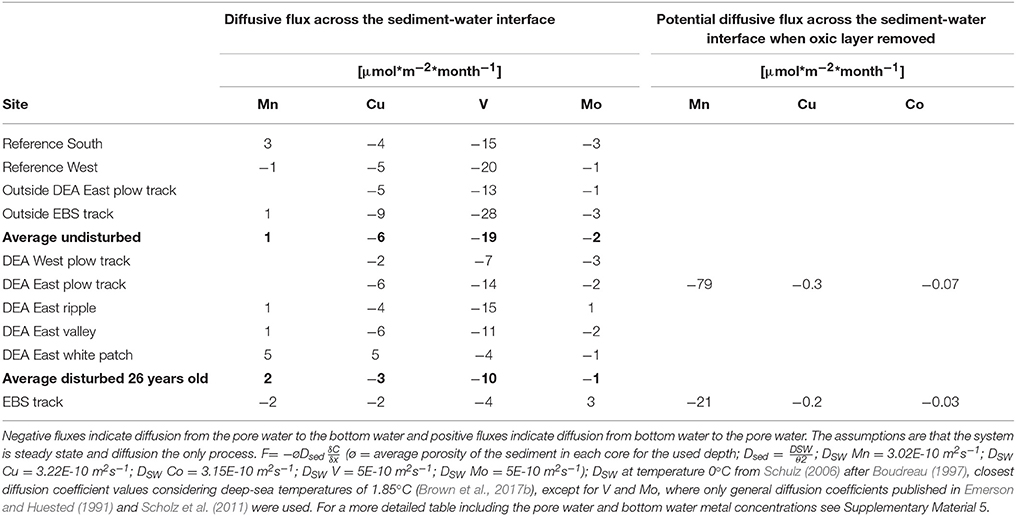
Table 3. Diffusive fluxes of selected dissolved metal ions across the sediment-water interface and potential fluxes across the sediment-water interface when the Mn-oxide rich layer is removed; based on gradients across the redox-boundary in cores from this study.
DOC and DAA as Indicators of Organic Matter Degradation
DOC and DAA can be intermediates of sedimentary organic matter degradation. DOC and DAA concentrations are elevated in pore waters compared to bottom water so that the sediments are sources of DOC and DAA to the water column (Lahajnar et al., 2005; Burdige and Komada, 2015). In the pore water, DOC and especially the more reactive DAA, may be further degraded to inorganic nutrients or reintegrated into the sediment by bacterial uptake or sorption processes (Burdige and Martens, 1990; Ding and Henrichs, 2002). DAA concentrations in near-shore pore water are elevated in the upper 25 cm and drop to values of 2-5 μmol/L at depth (Burdige and Martens, 1990), which also fits well with our deep-sea pore water data (Figure 9). DAA bottom water and pore water spectra are dominated by Ser>Gly>Ala>His>Orn>Asp (Supplementary Material 4), irrespective of disturbance and redox-zonation, which is quite different from sediment and suspended matter spectra that are dominated by Gly, Asp, Glu, and Ala or, respectively, by Gly, Glu, Asp, and Ser (Gaye et al., 2013) but similar to DAA spectra from the water column (Ittekkot and Degens, 1984). Pore waters tend to accumulate those amino acids which are preferably removed from the particulate phase, including Ser, Gly, and Glu (Seifert et al., 1990) as well as degradable amino acids (e.g., Met) and basic amino acids (e.g., Lys) preferentially sorbed to mineral surfaces (Ding and Henrichs, 2002). The latter indicate the degradation or desorption of amino acids of the particulate pool. In addition, pore waters also accumulate the non-protein amino acids β-Ala, γ-Aba, and Orn which are either degradation products of proteinaceous amino acids or are not taken up by bacteria (Seifert et al., 1990; Davis et al., 2009). It has been shown experimentally with cores from the Peru Basin that a few hours after a disturbance, particulate AA concentrations in the sediment and DOC in pore waters sharply increased. The increase in particulate AA was attributed to enhanced bacterial activity which could be related to spreading of fresh organic matter from deeper layers (Koschinsky et al., 2001b) and augmented by the oxygen availability in the upper sediments which may reinforce organic matter degradation (Lee, 1992). After 26 years, however, the concentration differences between disturbed and undisturbed sites are not so visible anymore so that degradation possibly slowed down due to decreasing quality of organic matter (Vonnahme et al., in prep.). The high DOC concentration in the DEA East plow track surface layer should therefore not be a remnant of the 1989 disturbance but rather due to a recent incident, such as a local input of organic material or bioturbation.
Conclusion
The solid phase results of the undisturbed sites show natural variability with respect to element concentrations, yet the profile shapes agree. The pore water profiles do not show major differences between the undisturbed and the 26-year old disturbed sites. Five weeks post-disturbance, the impacts were still visible in the pore water profiles but signs of regeneration in the upper centimeters were already visible and an elevated metal flux to the ocean seems to prevail on even shorter time scales. Differences in DOC and DAA concentrations as well as spectra are not visible or cannot be attributed to the disturbance after 26 years. In general, the re-establishment of a new steady-state in the solid phase takes longer than in the pore water. The differences between undisturbed and 26-year old disturbed sites, especially the loss or redistribution of Mn-oxide rich sediment, are clearly visible in the profiles. An important finding of our study is that degrees and types of disturbance differ strongly among the disturbed sites. The EBS track is quite distinct due to its recency but even the other five 26-year old disturbed sites vary with respect to concentrations of the metals—especially Mn, Mo, Ni, and Co—as well as profile shapes in the solid phase. As discussed above, these can be results of different disturbance impacts such as removal, mixing, redeposition of suspended sediment, and inversion or most often a unique combination of several impacts.
The geochemical variability which was discovered in the undisturbed as well as disturbed sites elucidates that the deep-sea is a highly complex system that is still poorly understood as has also been recently shown for the CCZ (Mewes et al., 2014, 2016; Mogollón et al., 2016; Kuhn et al., 2017; Volz et al., in review). With respect to polymetallic nodule mining, it will be necessary to carry out baseline studies on the geochemistry of the potentially impacted sites and reference sites for quite a high number of locations to assess the heterogeneity of both, the natural area and the types of impact. The difficulty of gaining representative baselines and ranges of disturbance impacts is a general challenge for deep-sea mining related research and has been discussed elsewhere, too (see for example Jones et al., 2017).
Metal concentrations in pore water are not suitable for monitoring purposes because their concentrations quickly reach a new steady-state after a disturbance, probably on time scales of months. Therefore, they could imply that the system has recovered which truly is not the case for other components. In the DISCOL area, the disturbance impact was most pronounced in the Mn-oxide rich top layer. Since it was shown in this study and previous work (Shaw et al., 1990; Koschinsky, 2001; Morford et al., 2005) that many other metals – such as Mo, Ni, Co, and Cu, are associated with Mn-oxides in this layer, Mn is a key parameter for monitoring, if not all parameters can be measured due to financial, technical, and time constraints in an industrial mining scenario. In addition to the oxygen penetration depth, knowing the Mn concentration in the solid phase and pore water gives a lot of insights into the geochemical system at this site, including potential release of other trace metals, and would be a useful parameter to measure pre-mining and post-mining for monitoring purposes. Mn is a good indicator for disturbance in sediments with a relatively shallow oxic layer, such as the Peru Basin. Areas with a different redox-zonation might have different key parameters because a largely oxic system (such as the CCZ where deep-sea polymetallic nodule mining is most likely to start) will be differently impacted (also see Cronan et al., 2010; Rühlemann et al., 2011; Mewes et al., 2014, 2016; Mogollón et al., 2016; Kuhn et al., 2017; Volz et al., in review). We are only able to draw this conclusion about Mn as a key parameter, however, because this small site has been extensively studied over a long period of time. Baseline studies are vital to (1) understand the system, (2) select key parameters, and (3) define thresholds. More extensive research in different geochemical seafloor systems and on a larger scale needs to be carried out before it can be determined what a negative impact on the environment may be and which thresholds should therefore not be exceeded.
Author Contributions
SP: research design, data collection, trace metal analyses and data interpretation, article drafting and revision. MH, AK, and SK: research design. MH: sampling, oxygen, POC, PON, porosity data collection, analyses and interpretation. BG: DOC and DAA analyses and data interpretation. AK, MH, BG, and SK: article revision. SP, MH, BG, SK, and AK: final approval of the version to be published.
Conflict of Interest Statement
The authors declare that the research was conducted in the absence of any commercial or financial relationships that could be construed as a potential conflict of interest.
Acknowledgments
We are deeply grateful to the crew of RV SONNE, the ROV KIEL 6000 team and the chief scientists Jens Greinert and Antje Boetius on cruise SO242/ 1 and 2 who made the sampling possible. Our great appreciation goes to Katja Schmidt, Annika Moje, Inken Preuss, Rajina Bajracharya, Tim Jesper Suhrhoff, Seinab Bohsung and Laura Ulrich for their help with laboratory work in the geochemistry laboratory at Jacobs University Bremen and sampling onboard RV SONNE. We thank Peggy Bartsch for DOC analyses and Niko Lahajnar for amino acid analyses carried out at the University of Hamburg as well as Meike Dibbern, Bettina Domeyer, Anke Bleyer and Regina Surberg for analytical work onboard RV SONNE and at GEOMAR. Thanks also go to Anne Peukert from GEOMAR, for providing the map. This work was funded by the German Federal Ministry of Education and Research in the framework of the JPI Oceans project MiningImpact (grant no. 03F0707A+G) and the Post-Grant-Fund (grant no. 16PGF0058). We also thank two reviewers for their helpful comments that improved this manuscript.
Supplementary Material
The Supplementary Material for this article can be found online at: https://www.frontiersin.org/articles/10.3389/fmars.2018.00117/full#supplementary-material
Footnotes
1. ^10 * standard deviation of acid blanks for each run.
References
Auguste, M., Mestre, N. C., Rocha, T. L., Cardoso, C., Cueff-Gauchard, V., Le Bloa, S., et al. (2016). Development of an ecotoxicological protocol for the deep-sea fauna using the hydrothermal vent shrimp Rimicaris exoculata. Aquat. Toxicol. 175, 277–285. doi: 10.1016/j.aquatox.2016.03.024
Barbier, E. B., Moreno-Mateos, D., Rogers, A. D., Aronson, J., Pendleton, L., Danovaro, R., et al. (2014). Protect the deep sea. Nature 505, 475–477. doi: 10.1038/505475a
Beck, M., Dellwig, O., Schnetger, B., and Brumsack, H. J. (2008). Cycling of trace metals (Mn, Fe, Mo, U, V, Cr) in deep pore waters of intertidal flat sediments. Geochim. Cosmochim. Acta 72, 2822–2840. doi: 10.1016/j.gca.2008.04.013
Boetius, A. (2015). RV SONNE Cruise Report SO242-2. JPI OCEANS Ecological Aspects of Deep-Sea Mining DISCOL Revisited. GEOMAR Helmholtz Centre for Ocean Research Kiel. GEOMAR Report 27.
Boudreau, B. P. (1997). Diagenetic Models and Their Implementation. Modelling Transport and Reactions in Aquatic Sediments. Berlin; Heidelberg; New York, NY; Barcelona; Budapest; Hong Kong; London; Milan; Paris; Santa Clara, CA; Singapore; Tokyo: Springer.
Brockmeyer, B., and Spitzy, A. (2013). Evaluation of a disc tube methodology for nano- and ultrafiltration of natural dissolved organic matter (DOM). Int. J. Org. Chem. 3, 17–25. doi: 10.4236/ijoc.2013.31A002
Brown, A., Thatje, S., and Hauton, C. (2017a). The effects of temperature and hydrostatic pressure on metal toxicity: insights into toxicity in the deep sea. Environ. Sci. Technol. 51, 10222–10231. doi: 10.1021/acs.est.7b02988
Brown, A., Wright, R., Mevenkamp, L., and Hauton, C. (2017b). A comparative experimental approach to ecotoxicology in shallow-water and deep-sea holothurians suggests similar behavioural responses. Aquat. Toxicol. 191, 10–16. doi: 10.1016/j.aquatox.2017.06.028
Burdige, D. J. (1993). The biogeochemistry of manganese and iron reduction in marine sediments. Earth Sci. Rev. 35, 249–284. doi: 10.1016/0012-8252(93)90040-E
Burdige, D. J., and Komada, T. (2015). “Biogeochemistry of marine dissolved organic matter,” Sediment Pore Waters, 2nd Edn., eds D. A. Hansell and C. A. Carlson (Burlington: Academic Press), 535–577.
Burdige, D. J., and Martens, C. S. (1990). Biogeochemical cycling in an organic-rich coastal marine basin: 11. The sedimentary cycling of dissolved, free amino acids. Geochim. Cosmochim. Acta 54, 3033–3052. doi: 10.1016/0016-7037(90)90120-A
Cronan, D. S., Rothwell, G., and Croudace, I. (2010). An ITRAX geochemical study of ferromanganiferous sediments from the Penrhyn basin, South Pacific Ocean. Mar. Georesour. Geotechnol. 28, 207–221. doi: 10.1080/1064119X.2010.483001
Davies, A. J., Roberts, J. M., and Hall-Spencer, J. (2007). Preserving deep-sea natural heritage: emerging issues in offshore conservation and management. Biol. Conserv. 138, 299–312. doi: 10.1016/j.biocon.2007.05.011
Davis, J., Kaiser, K., and Benner, R. (2009). Amino acid and amino sugar yields and compositions as indicators of dissolved organic matter diagenesis. Org. Geochem. 40, 343–352. doi: 10.1016/j.orggeochem.2008.12.003
Ding, X., and Henrichs, M. (2002). Adsoption and desorption of proteins and polyamino acid by clay minerals and marine sediments. Mar. Chem. 77, 225–237. doi: 10.1016/S0304-4203(01)00085-8
Emerson, S. R., and Huested, S. S. (1991). Ocean anoxia and the concentrations of molybdenum and vanadium in seawater. Mar. Chem. 34, 177–196. doi: 10.1016/0304-4203(91)90002-E
Fritsche, U., Koschinsky, A., and Winkler, A. (2001). The different diffusive transport behaviours of some metals in layers of Peru Basin surface sediment. Deep Res. Part II Top. Stud. Oceanogr. 48, 3653–3681. doi: 10.1016/S0967-0645(01)00061-3
Froelich, P. N., Klinkhammer, G. P., Bender, M. L., Luedtke, N. A., Heath, G. R., Cullen, D., et al. (1979). Early oxidation of organic matter in pelagic sediments of the eastern equatorial Atlantic: suboxic diagenesis. Geochim. Cosmochim. Acta 43, 1075–1090. doi: 10.1016/0016-7037(79)90095-4
Gaye, B., Nagel, B., Dähnke, K., Rixen, T., Lahajnar, N., and Emeis, K. C. (2013). Amino acid composition and δ15N of suspended matter in the Arabian sea: implications for organic matter sources and degradation. Biogeosciences 10, 7689–7702. doi: 10.5194/bg-10-7689-2013
GEOMAR (2017). JPI Oceans - Ecological Aspects of Deep-Sea Mining. Available online at: https://jpio-miningimpact.geomar.de/ [Accessed September 15, 2017].
Gingele, F. X., and Kasten, S. (1994). Solid-phase manganese in Southeast Atlantic sediments: implications for the paleoenvironment. Mar. Geol. 121, 317–332. doi: 10.1016/0025-3227(94)90037-X
Glover, A. G., and Smith, C. R. (2003). The deep-sea floor ecosystem: current status and prospects of anthropogenic change by the year 2025. Environ. Conserv. 30, 219–241. doi: 10.1017/S0376892903000225
Gollner, S., Kaiser, S., Menzel, L., Jones, D. O. B., Brown, A., Mestre, N. C., et al. (2017). Resilience of benthic deep-sea fauna to mining activities. Mar. Environ. Res. 129, 76–101. doi: 10.1016/j.marenvres.2017.04.010
Grasshoff, K., Kremling, K., and Ehrhardt, M. (1999). Methods of Seawater Analysis. Weinheim: Wiley-VCH.
Greinert, J. (2015). RV SONNE Cruise Report SO242-1. JPI OCEANS Ecological Aspects of Deep-Sea Mining DISCOL Revisited. GEOMAR Helmholtz Centre for Ocean Research Kiel. GEOMAR Report 26.
Haeckel, M., König, I., Riech, V., Weber, M. E., and Suess, E. (2001). Pore water profiles and numerical modelling of biogeochemical processes in Peru Basin deep-sea sediments. Deep. Res. Part II Top. Stud. Oceanogr. 48, 3713–3736. doi: 10.1016/S0967-0645(01)00064-9
Heggie, D., Kahn, D., and Fischer, K. (1986). Trace metals in metalliferous sediments, MANOP Site M: interfacial pore water profiles. Earth Planet. Sci. Lett. 80, 106–116. doi: 10.1016/0012-821X(86)90023-3
Heggie, D., and Lewis, T. (1984). Cobalt in pore waters of marine sediments. Nature 311, 453–455. doi: 10.1038/311453a0
Hein, J. R., Mizell, K., Koschinsky, A., and Conrad, T. A. (2013). Deep-ocean mineral deposits as a source of critical metals for high- and green-technology applications: comparison with land-based resources. Ore Geol. Rev. 51, 1–14. doi: 10.1016/j.oregeorev.2012.12.001
International Seabed Authority. (2014). Deep seabed minerals contractors. Available online at: https://www.isa.org.jm/deep-seabed-minerals-contractors [Accessed April 22, 2015].
Ittekkot, V., and Degens, E. T. (1984). The role of organic matter in the WaddenSea - Tracking of marine dissolved and particulate organic carbon - environmental implications. Netherlands Inst. Sea Res. Publ. Ser. 10, 179–194.
Jones, D. O. B., Kaiser, S., Sweetman, A. K., Smith, C. R., Menot, L., Vink, A., et al. (2017). Biological responses to disturbance from simulated deep-sea polymetallic nodule mining. PLoS ONE 12:e0171750. doi: 10.1371/journal.pone.0171750
Klinkhammer, G., Heggie, D. T., and Graham, D. W. (1982). Metal diagenesis in oxic marine sediments. Earth Planet. Sci. Lett. 61, 211–219. doi: 10.1016/0012-821X(82)90054-1
Klinkhammer, G. P. (1980). Early diagenesis in sediments from the eastern equatorial Pacific, II. Pore water metal results. Earth Planet. Sci. Lett. 49, 81–101. doi: 10.1016/0012-821X(80)90151-X
König, I., Drodt, M., Suess, E., and Trautwein, A. X. (1997). Iron reduction through the tan-green color transition in deep-sea sediments. Geochim. Cosmochim. Acta 61, 1679–1683. doi: 10.1016/S0016-7037(97)00007-0
König, I., Haeckel, M., Lougear, A., Suess, E., and Trautwein, A. X. (2001). A geochemical model of the Peru Basin deep-sea floor - and the response of the system to technical impacts. Deep. Res. Part II Top. Stud. Oceanogr. 48, 3737–3756. doi: 10.1016/S0967-0645(01)00065-0
Koschinsky, A. (2001). Heavy metal distributions in Peru Basin surface sediments in relation to historic, present and disturbed redox environments. Deep. Res. Part II Top. Stud. Oceanogr. 48, 3757–3777. doi: 10.1016/S0967-0645(01)00066-2
Koschinsky, A., Fritsche, U., and Winkler, A. (2001a). Sequential leaching of Peru Basin surface sediment for the assessment of aged and fresh heavy metal associations and mobility. Deep. Res. Part II Top. Stud. Oceanogr. 48, 3683–3699. doi: 10.1016/S0967-0645(01)00062-5
Koschinsky, A., Gaye-Haake, B., Arndt, C., Maue, G., Spitzy, A., Winkler, A., et al. (2001b). Experiments on the influence of sediment disturbances on the biogeochemistry of the deep-sea environment. Deep. Res. Part II Top. Stud. Oceanogr. 48, 3629–3651. doi: 10.1016/S0967-0645(01)00060-1
Koschinsky, A., Winkler, A., and Fritsche, U. (2003). Importance of different types of marine particles for the scavenging of heavy metals in the deep-sea bottom water. Appl. Geochemistry 18, 693–710. doi: 10.1016/S0883-2927(02)00161-0
Kowalski, N., Dellwig, O., Beck, M., Grunwald, M., Fischer, S., Piepho, M., et al. (2009). Trace metal dynamics in the water column and pore waters in a temperate tidal system: response to the fate of algae-derived organic matter. Ocean Dyn. 59, 333–350. doi: 10.1007/s10236-009-0192-7
Kuhn, T., Versteegh, G. J. M., Villinger, H., Dohrmann, I., Heller, C., Koschinsky, A., et al. (2017). Widespread seawater circulation in 18–22 Ma oceanic crust: impact on heat flow and sediment geochemistry. Geology 45, 799–802. doi: 10.1130/G39091.1
Lahajnar, N., Rixen, T., Gaye-Haake, B., Schäfer, P., and Ittekkot, V. (2005). Dissolved organic carbon (DOC) fluxes of deep-sea sediments from the Arabian Sea and NE Atlantic. Deep. Res. Part II Top. Stud. Oceanogr. 52, 1947–1964. doi: 10.1016/j.dsr2.2005.05.006
Lee, C. (1992). Controls on organic carbon preservation: the use of stratified water bodies to compare intrinsic rates of decomposition in oxic and anoxic systems. Geochim. Cosmochim. Acta 56, 3323–3335. doi: 10.1016/0016-7037(92)90308-6
Marchig, V., Von Stackelberg, U., Hufnagel, H., and Durn, G. (2001). Compositional changes of surface sediments and variability of manganese nodules in the Peru Basin. Deep. Res. Part II Top. Stud. Oceanogr, 48, 3523–3547. doi: 10.1016/S0967-0645(01)00055-8
Martins, I., Goulart, J., Martins, E., Morales-Román, R., Marín, S., Riou, V., et al. (2017). Physiological impacts of acute Cu exposure on deep-sea vent mussel Bathymodiolus azoricus under a deep-sea mining activity scenario. Aquat. Toxicol. 193, 40–49. doi: 10.1016/j.aquatox.2017.10.004
Mengerink, K. J., van Dover, C. L., Ardon, J., Baker, M., Escobar-Briones, E., Gjerde, K., et al. (2014). A call for deep-ocean stewardship. Science 344, 696–698. doi: 10.1126/science.1251458
Mevenkamp, L., Brown, A., Hauton, C., Kordas, A., Thatje, S., and Vanreusel, A. (2017). Hydrostatic pressure and temperature affect the tolerance of the free-living marine nematode Halomonhystera disjuncta to acute copper exposure. Aquat. Toxicol. 192, 178–183. doi: 10.1016/j.aquatox.2017.09.016
Mewes, K., Mogollón, J. M., Picard, A., Rühlemann, C., Kuhn, T., Nöthen, K., et al. (2014). Impact of depositional and biogeochemical processes on small scale variations in nodule abundance in the Clarion-Clipperton fracture zone. Deep. Res. Part I Oceanogr. Res. Pap. 91, 125–141. doi: 10.1016/j.dsr.2014.06.001
Mewes, K., Mogollón, J. M., Picard, A., Rühlemann, C., Eisenhauer, A., Kuhn, T., et al. (2016) Diffusive transfer of oxygen from seamount basaltic crust into overlying sediments: an example from the Clarion-Clipperton Fracture Zone. Earth Planet Sci. Lett. 433, 215–225. doi: 10.1016/j.epsl.2015.10.028
Mogollón, J. M., Mewes, K., and Kasten, S. (2016). Quantifying manganese and nitrogen cycle coupling in manganese-rich, organic carbon-starved marine sediments: examples from the Clarion-Clipperton fracture zone. Geophys. Res. Lett. 43, 1–10. doi: 10.1002/2016GL069117
Morford, J. L., and Emerson, S. (1999). The geochemistry of redox sensitive trace metals in sediments. Geochim. Cosmochim. Acta 63, 1735–1750. doi: 10.1016/S0016-7037(99)00126-X
Morford, J. L., Emerson, S. R., Breckel, E. J., and Kim, S. H. (2005). Diagenesis of oxyanions (V, U, Re, and Mo) in pore waters and sediments from a continental margin. Geochim. Cosmochim. Acta 69, 5021–5032. doi: 10.1016/j.gca.2005.05.015
Müller, P. J., Hartmann, M., and Suess, E. (1988). “The chemical environment of pelagic sediments,” in The Manganese Nodule Belt of the Pacific Ocean Geological Environment, Nodule Formation, and Mining Aspects, Chapter 5.1, eds P. Halbach, G. Friedrich, and U. von Stackelberg (Stuttgart: Ferdinand Enke Verlag), 70–90.
Oebius, H. U., Becker, H. J., Rolinski, S., and Jankowski, J. A. (2001). Parametrization and evaluation of marine environmental impacts produced by deep-sea manganese nodule mining. Deep. Res. Part II Top. Stud. Oceanogr. 48, 3453–3467. doi: 10.1016/S0967-0645(01)00052-2
Ramirez-Llodra, E., Tyler, P. A., Baker, M. C., Bergstad, O. A., Clark, M. R., Escobar, E., et al. (2011). Man and the last great wilderness: human impact on the deep sea. PLoS ONE 6:e22588. doi: 10.1371/journal.pone.0022588
Roje, V. (2010). Multi-elemental analysis of marine sediment reference material MESS-3: one-step microwave digestion and determination by high resolution inductively coupled plasma-mass spectrometry (HR-ICP-MS). Chem. Pap. 64, 409–414. doi: 10.2478/s11696-010-0022-x
Rühlemann, C., Kuhn, T., Wiedicke, M., Kasten, S., Mewes, K., and Picard, A. (2011). “Current Status of Manganese Nodule Exploration in the German License Area,” in Proceedings of the Ninth (2011) ISOPE Ocean Mining Symposium (Maui, HI), 168–173.
Sawlan, J. J., and Murray, J. W. (1983). Trace metal remobilization in the interstitial waters of red clay and hemipelagic marine sediments. Earth Planet. Sci. Lett. 64, 213–230. doi: 10.1016/0012-821X(83)90205-4
Scholz, F., Hensen, C., Noffke, A., Rohde, A., Liebetrau, V., and Wallmann, K. (2011). Early diagenesis of redox-sensitive trace metals in the Peru upwelling area - response to ENSO-related oxygen fluctuations in the water column. Geochim. Cosmochim. Acta 75, 7257–7276. doi: 10.1016/j.gca.2011.08.007
Schriever, G., Koschinsky, A., and Bluhm, H. (1996). Cruise Report SO106 ATESEPP Impacts of Potential Technical Interventions on the Deep-Sea Ecosystem of the Southeast Pacific Off Peru. Berichte aus dem Zentrum für Meeres- und Klimaforschung. Institut für Hydrobiologie und Fischereiwissenschaft. Hamburg.
Schulz, H. D. (2006). “Quantification of early diagenesis: dissolved consitutents in pore water and signals in the solid phase,” in Marine Geochemistry, eds H. D. Schulz and M. Zabel (Berlin, Heidelberg: Springer-Verlag), 73–124.
Seeberg-Elverfeldt, J., Schlüter, M., Feseker, T., and Kölling, M. (2005). Rhizon sampling of porewater near the sediment-water Interface of aquatic systems. Limnol. Oceanogr. Methods 3, 361–371. doi: 10.4319/lom.2005.3.361
Seifert, R., Emeis, K. C., Michaelis, W., and Degens, E. T. (1990). “Amino acids and carbohydrates in sediments and interstitial waters from Site 681, Leg 112, Peru Continental Margin,” in Proceedings of the Ocean Drilling Program, Scientific Results (College Station, TX), 12, 555–566.
Shaw, T. J., Gieskes, J. M., and Jahnke, R. A. (1990). Early diagenesis in differing depositional environments: the response of transition metals in pore water. Geochim. Cosmochim. Acta 54, 1233–1246. doi: 10.1016/0016-7037(90)90149-F
Thiel, H. (2001). Use and protection of the deep sea. An introduction. Deep. Res. Part II Top. Stud. Oceanogr. 48, 3427–3431. doi: 10.1016/S0967-0645(01)00050-9
Thiel, H., and Forschungsverbund Tiefsee-Umweltschutz. (2001). Evaluation of the environmental consequences of polymetallic nodule mining based on the results of the TUSCH research association. Deep. Res. Part II Top. Stud. Oceanogr. 48, 3433–3452. doi: 10.1016/S0967-0645(01)00051-0
Thiel, H., and Schriever, G. (1990). Deep-sea mining, environmental impact and the DISCOL project. Ambio 19, 245–250.
van Dover, C. L. (2011). Tighten regulations on deep-sea mining. Nature 470, 31–33. doi: 10.1038/470031a
van Dover, C. L., Aronson, J., Pendleton, L., Smith, S., Arnaud-Haond, S., Moreno-Mateos, D., et al. (2014). Ecological restoration in the deep sea: desiderata. Mar. Policy 44, 98–106. doi: 10.1016/j.marpol.2013.07.006
Weber, M. E., Wiedicke, M., and Riech, V. (1995). Carbonate preservation history in the Peru Basin: paleoceanographic implications. Paleoceanography 10, 775–800. doi: 10.1029/95PA01566
Keywords: heavy metals, deep-sea mining, ecosystem disturbance, long-term changes, DISCOL
Citation: Paul SAL, Gaye B, Haeckel M, Kasten S and Koschinsky A (2018) Biogeochemical Regeneration of a Nodule Mining Disturbance Site: Trace Metals, DOC and Amino Acids in Deep-Sea Sediments and Pore Waters. Front. Mar. Sci. 5:117. doi: 10.3389/fmars.2018.00117
Received: 21 September 2017; Accepted: 20 March 2018;
Published: 06 April 2018.
Edited by:
Ricardo Serrão Santos, University of the Azores, PortugalReviewed by:
Mustafa Yucel, Middle East Technical University, TurkeyStephanie Ann Carr, Hartwick College, United States
Copyright © 2018 Paul, Gaye, Haeckel, Kasten and Koschinsky. This is an open-access article distributed under the terms of the Creative Commons Attribution License (CC BY). The use, distribution or reproduction in other forums is permitted, provided the original author(s) and the copyright owner are credited and that the original publication in this journal is cited, in accordance with accepted academic practice. No use, distribution or reproduction is permitted which does not comply with these terms.
*Correspondence: Sophie A. L. Paul, s.paul@jacobs-university.de
 Sophie A. L. Paul
Sophie A. L. Paul Birgit Gaye2
Birgit Gaye2  Sabine Kasten
Sabine Kasten Andrea Koschinsky
Andrea Koschinsky